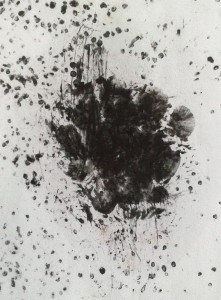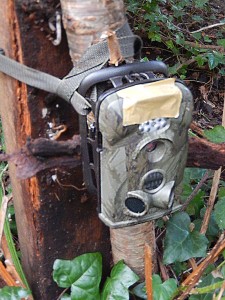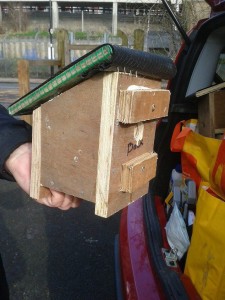(See Vole Patrol Episode 1)
Science proceeds in slow steps, and things far more often become clear gradually than in dramatic Eureka! moments.
After “hours of fun” trying to decipher sheets of paper covered in a mass of footprints, we learnt that most of what we had seen were mouse/vole (indistinguishable as prints), squirrel, cat, and rat. Some of the West London survey sites in London Wildlife Trust’s Vole Patrol had evidence of other mammals, from camera trap shots of foxes and badgers to a fuzzy glimpse of an elusive otter.

Huma had been busy visiting all the sites, teaching volunteers, getting people to build mammal nestboxes (like birdboxes, but with the opening round the back!), and inspecting a lot of shrew tubes and sheets of paper covered in footprints.
The five-toed “Yeti” footprint turned out to be a cat (notice the streaks from its furry feet) which had placed one four-toed foot almost in the print of another, so there are two heels of the hand and the middle three toes double-printed. Of such are mysteries made.

We all enjoyed looking at what the camera traps had caught. The video clips were much easier to interpret than the still images. Several small children had crept up to the cameras and spent a while peering into the lenses (What? Me? I’m on camera?). Two foxes cavorted with long bushy tails. A badger ambled past like a crotchety old gentlemen on the way to his club. Mice with big round ears, surely wood mice, bounced and scuttled in and out of the field of view: sometimes only the glint of their eyes revealed their presence, and sometimes even that was very small and only at the edge of the frame.
Then we cleared an easily-wiped formica-topped table for … shrew poo analysis. We had up to ten baited tubes from each site. With surgical gloves, dissecting probes, tweezers and hand lenses, we carefully emptied each tube into a Petri dish and looked for mammal pellets. Mice eat seeds and produce solid, compact pellets, round one end, pointed the other. Shrews eat insects and produce pellets of a similar shape, but made of non-stick fragments of insect cuticle, so their pellets tend to crumble. Many of the tubes contained nothing; one or two had been lost in the field; several contained mouse pellets, most likely wood mouse; a few seemed to contain shrew pellets. We dropped the pellets into sealable inch-long plastic tubes labelled with their site, the date, and the shrew tube number, and recorded what we had found in the logbook, to much cheerful banter.

It will become much easier to determine which wood contains which mammals when we start trapping in a fortnight’s time. Then we have to get up and be at the reserves by 6:30 in the morning for a two-hour stint, to be repeated in the afternoon. My family will be amazed if I manage any kind of early morning.
